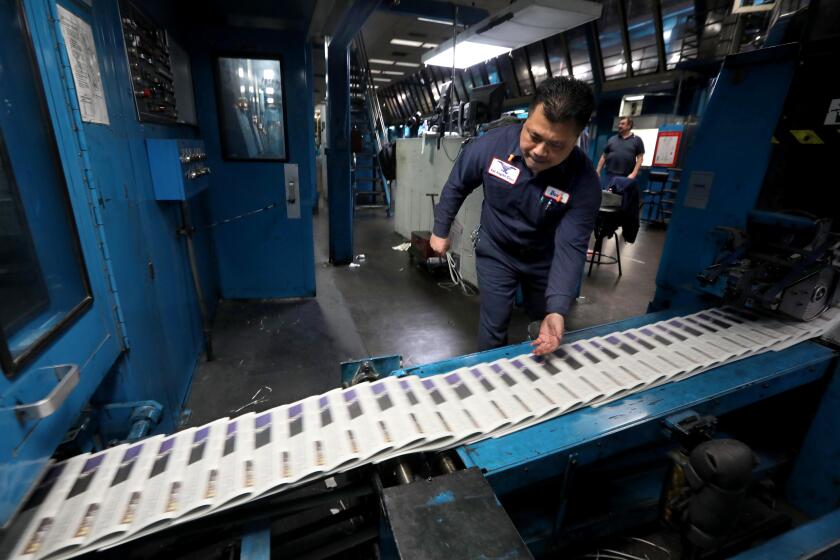2 Hospitals Map Out Their Strategies in War to Lure New Patients : Health care: Los Robles and Westlake facilities consider costly expansions as way to ensure success.
A health care war is under way in the Thousand Oaks area, and the strain is starting to show.
With occupancy rates as low as 5% in one ward, Westlake Medical Center in Westlake Village is gunning for expansion, hoping to attract new patients with a vastly improved array of services.
On the north side of Thousand Oaks, Los Robles Regional Medical Center is retrenching after the hospital saw its occupancy rate drop by 25% in three months. Administrators say they are cutting staff and may form a partnership with another county hospital to become more competitive.
Even as they re-examine their priorities, Los Robles officials say, plans for a costly expansion will probably proceed.
Health care reform experts say the battle is another example of a drama being played out across the country as hospitals cling to old, costly business practices while facing a patient population that is balking at ever-mounting health care bills.
“This is a wonderful example of the kind of unplanned expansion that leads to the spiral of health care costs that President Clinton is dealing with,” said Donald Light, a specialist in comparative health care at the University of Medicine and Dentistry of New Jersey. “It’s a microcosm.”
Los Robles spokeswoman Susan Odegaard Turner said her hospital is just trying to fill a void.
“We are trying to meet the needs that already exist in the community,” she said. “In designing our improvements, we do not consider what Westlake is doing.”
The two hospitals have pitched their battle camps on what is increasingly an economic minefield in modern health care. The future is highly uncertain, as health care professionals nervously await the September unveiling of Clinton’s managed care plan. Legislation arising from the Administration’s proposals could permanently alter the field of health care, and previews coming out of Washington are often hazy and conflicting.
Rising health care revenues--evidenced in the higher hospital bills seen by consumers and their insurance companies--continue to make the hospital business a profitable one, even in the worst of economic times. But the recession has taken a toll on much of the industry.
Financially strapped patients are putting off elective surgeries and waiting longer when an ache occurs to visit the doctor’s office, industry experts say.
Money is getting tighter as more patients and employers switch from costly traditional insurance plans to more frugal managed care plans, which pay less for each procedure and discourage patients from checking into the hospital.
The number of patients subscribing to managed care plans doubled at Los Robles last year, said Robert Quist, the hospital’s chief administrator. At Westlake Medical Center, managed care patients have increased from 30% to 48% of the hospital’s total patient population over the last four years, said Managing Director K.D. Justyn.
Additionally, thanks to scientific advances, there are fewer hospital patients nationwide than there were even 10 years ago. Sophisticated testing instruments detect problems sooner. Surgeries that once required days of hospital stay now command one morning in an outpatient care center. Medicine is working faster and better.
So far, the ‘90s have been kinder to Los Robles than they have been to Westlake Medical Center. Last year, the smaller hospital filled only 26% of its beds, on average, and posted a $665,108 pretax profit that was only 2.6% of its total operating revenue.
Both figures are below average in the industry. The national community hospital occupancy average in 1991, according to the American Hospital Assn., was 66.1%. The average pretax hospital profit in 1991 was 4.3% of total operating revenue, according to association figures.
By contrast, Los Robles filled an average of 47% of its beds last year and reported a hefty pretax profit of 14% on a total operating revenue of $73.1 million. The situation dramatically changed for the worse, however, in the second quarter of 1993, with the bed occupancy rate dropping to 40% between April and June. Hospital officials would not release financial data for the second quarter of 1993, and the records have not yet been processed by the state.
*
Speaking of the rivalry, Los Robles Chief Administrator Quist said last year: “Somebody’s not going to make it. And we fully intend to be the survivor here. . . . It’s just tough being a small hospital today.”
So Westlake Medical Center is taking a risk.
The hospital is beefing up its maternity ward, adding a new north wing, and devoting about 40% of its space to a high-technology cancer center that officials promise will rival some of the best oncology facilities in the country. The cost to the hospital, which is owned by for-profit Universal Health Services Inc., will be about $15 million.
“A medical center is a business,” said Kris Carroway, marketing director for the hospital. “We’re feeling the pinch (of the recession) too. We have to look at expanding our market segments and the only way to do that is to offer a service that will accommodate that need.”
The big gun in its armory is the Salick Cancer Center, a high-tech treatment unit now in nine locations across the United States, including one at Cedars-Sinai Medical Center in Los Angeles. Unlike most other cancer centers owned by Salick Health Care Inc., the local unit will be a joint venture with Westlake Medical Center.
Salick facilities are renowned both for the low costs they achieve in providing cancer care in bulk and on an outpatient basis, and for the great profits they show. In 1992, Salick reported after-tax profits of $6.9 million.
The centers offer cancer patients one-stop care in an outpatient facility that provides personal service by top oncologists using the latest technology. The idea has proved so popular that many local cancer patients now commute up to two hours each way for weekly or daily treatment at the Cedars-Sinai center.
Westlake Medical Center officials hope their new Salick branch will widen the hospital’s base beyond the glutted local market, attracting patients from Santa Barbara to the San Fernando Valley.
“You will probably not travel another 10 miles to set a broken leg, but you will travel 10 miles for cancer treatment,” Carroway said.
The cancer center will eventually claim 40% of the hospital’s space, taking over what is now the entire back wing. Hospital officials say they are banking on services like the cancer center and the soon-to-be-expanded obstetrics unit to draw patients back to the hospital for other services, filling now-empty beds.
*
Bed space lost to the cancer center will be replenished when the north wing is built, adding an extra 78,000 square feet and replacing many semiprivate rooms with private ones. The hospital also will expand its emergency room and outpatient center.
“We basically hold their hands,” said nurse Peggy Over, the obstetrics unit’s director, about her division’s attitude toward customer service. “People tell me coming in that they get more attention.”
Hospital officials hope that personal touch will endear their institution with the next generation of insurers. In a future world of managed health care, the hospital will compete with health care providers from across Los Angeles and Ventura counties for the limited dollars of regional health care alliances, said Art Kaplan, a member of the White House Health Care Task Force and a bioethics professor at the University of Minnesota.
Westlake Medical Center officials could pitch their hospital both as a luxury alternative for upscale clientele and as a convenient, one-stop cancer center for the nearby metropolitan area.
“It’s a gamble, because it’s a matter of price and quality that they are going to compete on,” Kaplan said. “It’s going to be tough, being the new (cancer) center on the block.”
With much of its focus shifted to comprehensive cancer care, Westlake Medical Center must persuade these future insurers that its cancer care is either cheaper than the competition’s, or more convenient than trekking to the well-established Cedars’ center, Kaplan said. And, he added, in a system emphasizing stringent cost containment and little duplication of services, “insurance companies may not care if (Westlake Medical Center) is closer.”
*
Justyn, Westlake Medical Center’s administrator, said the hospital does not see its plans as a gamble. “We are positioning this hospital to focus more on outpatient care rather than the current direction of inpatient care. We feel we are really following the edict of the future.”
Los Robles--until this month--also planned a sizable expansion.
It planned to improve its maternity unit, add two new open-heart surgery rooms and a neonatal facility for premature infant care, and make other minor improvements. The total bill for the improvements at Los Robles, which is owned by the for-profit Hospital Corp. of America, would come to about $6 million.
Hospital officials say they will probably go ahead with the expansion, having spent the last two years meeting with architects and submitting plans for state approval. But the sudden dip in its occupancy rate, accompanied by declining revenues, has forced administrators to reassess their plans.
On July 16, the hospital laid off 12 employees from various departments. Many more employees had their hours cut back, and the nursing staff was asked not to refrain from calling in part-time and per diem workers.
Chief Administrator Quist said the hospital is feeling the same recession that has hit other health care providers.
“Last year was a decent year for us,” Quist said. “We are one of the last hospitals in the county to go through this.”
Indeed, Simi Valley Hospital and Health Care Services has laid off more employees than Los Robles since the recession began, and last year it ran a debt of more than $1.6 million. Administrators at Westlake Medical Center said they have been replacing many full-time workers with part-time and per diem employees for the last three years in an effort to cut costs.
Los Robles directors formed committees throughout the institution to find ways to cut costs. An outside consulting team will advise management on how to streamline further, Quist said.
*
And, he added, Los Robles recently began talking to another Ventura County hospital, which he would not identify, about pooling services and resources to further reduce costs.
“We’re hoping that the last couple of months is just a big blip on the screen,” he said. “But the scary thing is we just don’t know.”
Health care reform experts say that if Los Robles is to position itself for the coming decade, it must invest heavily in low-cost primary and preventive health care as well as high-tech and auxiliary services.
“The survival of primary, general hospitals is going to hinge on . . . whether or not they are cost-effective,” Kaplan said. “If Los Robles could be big enough to pull people in and be a Wal-Mart-type hospital, then it is possible.”
Los Robles officials say they are already traveling the route toward what administrator Odegaard Turner called an “integrated health care system,” involving community education projects, prevention and screening programs, and wellness programs.
Both improvement projects--if they go forward--will to some extent duplicate what is already available in or near the community. But for Westlake Medical Center, spending more than twice what Los Robles does in a market where it is already the underdog, the stakes are higher.
Los Robles administrators, for example, insist that their cancer care facilities are as sophisticated as any that the Salick company could install at Westlake Medical Center. Westlake Medical Center and Salick officials say they are counting on the amenities their center will offer and the high, concentrated quality of care to draw patients away from Los Robles and other nearby hospitals.
*
The Los Robles neonatal unit would be the first in the east county, but one of at least three in a 40-minute radius of Thousand Oaks. The obstetrics overhaul will furnish the unit with five new labor-delivery-recovery rooms. The current maternity ward is, on average, half occupied. The expanding obstetrics unit at Westlake Medical Center was 35% occupied last year.
Health care reform advocates argue that such duplication is precisely what hospitals should be avoiding in an age where the cost of health care has already spiraled beyond what many can afford.
“When hospitals go to war in an environment where there’s basically a blank-check health care system like we have now, society ends up being the loser,” said Kevin Anderson, a spokesman for the Washington, D.C.-based Alliance for Health Care Reform. “But that blank check is starting to shrink.”
More to Read
Start your day right
Sign up for Essential California for news, features and recommendations from the L.A. Times and beyond in your inbox six days a week.
You may occasionally receive promotional content from the Los Angeles Times.






